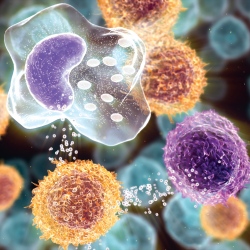
University of Toronto researchers have invented a new tissue engineering tool that makes uniform, layered, large patches of engineered tissue that could one day be used as grafts for burn victims or vascular patches.
Along with graduate students from their labs — Lian Leng, Boyang Zhang, and Arianna McAllister — Associate Professor Axel Guenther of the Department of Mechanical and Industrial Engineering, cross-appointed to the Institute of Biomaterials and Biomedical Engineering (IBBME), and Associate Professor Milica Radisic, core professor at IBBME and the Department of Chemical Engineering and Applied Chemistry, have invented a new device that may allow for the uniform, large-scale engineering of tissue.
“There’s a lot of interest in soft materials, particularly biomaterials,” explains Associate Professor Axel Guenther of the Department of Mechanical and Industrial Engineering, “but until now no one has demonstrated a simple and scalable one-step process to go from microns to centimeters.”
Scientists manipulate biomaterials into the micro-device through several channels. The biomaterials are then mixed, causing a chemical reaction that forms a “mosaic hydrogel” — a sheet-like substance compatible with the growth of cells into living tissues, into which different types of cells can be seeded in very precise and controlled placements.
Unique to this new approach to tissue engineering, however, and unlike more typical methods for tissue engineering (for instance, scaffolding, the seeding of cells onto an artificial structure capable of supporting three-dimensional tissue formation), cells planted onto the mosaic hydrogel sheets are precisely incorporated into the mosaic hydrogel sheet just at the time it’s being created — generating the perfect conditions for cells to grow.
